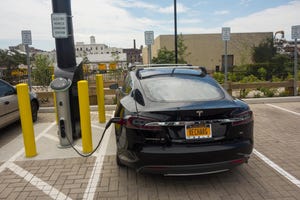Five takeaways from Verizon's analyst event
Verizon didn't disclose any major new objective or strategy, but company officials provided updates on Verizon's leadership team, its private wireless sales, its fixed wireless efforts, and more.

Verizon laid out its broad strategy for 2024 during an hour-long analyst event this week, but company officials didn't offer too many grand pronouncements, nor did Verizon set any new, major strategic objectives.
Broadly, Verizon's message during the event was that the company is now on firmer footing than it has been during the past few years of customer losses.
One telling exchange during the event involved a question about whether Verizon can grow faster than the current US rate of inflation. Yes, the company can do that, according to Verizon CEO Hans Vestberg. And he suggested the company might be able to do that in the coming years, as 5G matures and more opportunities emerge. But he declined to change Verizon's current 2024 guidance of total wireless service revenue growth of between 2% and 3.5%.
The current rate of inflation in the US is around 3.4%.
Regardless, Verizon officials painted a relatively positive outlook for the company. The company is now growing its customer base, it's lowering its capital spending, and it's investing into potential growth areas like prepaid, fixed wireless and private wireless.
Here are five takeaways from Verizon's 2024 analyst event:
1, The team continues to change
In the past year or so, a number of top executives have either departed the company or moved to a new position. The latest: Rima Qureshi, Verizon's EVP and chief strategy officer, will leave the company and be replaced by Chris Bartlett. Bartlett previously headed Verizon Ventures before becoming CFO of Verizon's business division last year.
Other executives that have recently headed for the door: comms chief Jim Gerace, CMO Diego Scotti and CTO Ed Chan.
Those departures follow the restructuring Verizon's Vestberg implemented in May of last year, putting new officials in charge of Verizon's key network, consumer and business units.
2, Private wireless and edge computing will be a thing... eventually
Verizon officials remained optimistic about the potential for edge computing and private wireless networking, but they declined to offer any firm numbers on the business.
"I still firmly believe in the opportunities," Vestberg said in response to a question on Verizon's private wireless networking business. He said some of Verizon's customers have moved beyond the trial phase and are expanding their deployments, but "it's still going to be a while until it's a meaningful revenue."
"This is a long play for us," Vestberg said.
At the beginning of 2023, Verizon officials backtracked on their previous goal of $1 billion in revenues from public MEC (multiaccess edge computing) services by 2025.
This week, Vestberg again acknowledged the misstep. "I was too early on 5G mobile edge compute," he said.
Verizon, however, isn't the only company to find lower-than-expected demand for edge computing and private wireless networking.
3, FWA remains a bright spot
Verizon officials touted the ongoing success of the company's fixed wireless access (FWA) offering. Indeed, the growth of FWA services from the likes of T-Mobile, Verizon and, lately, AT&T has cut into the core cable business of companies like Charter Communications.
"Customers like the product we are putting out," said Sowmyanarayan Sampath, the head of Verizon's consumer business, during the company's analyst event this week. Sampath said Verizon is entering the "next stage" of its FWA plan, which involves offering several different tiers of service and working to encourage users to bundle Verizon's FWA service with its mobility products. Along those lines, he said roughly 80% of Verizon's FWA customers currently subscribe to its smartphone service plans.
"Our product is shining," he said, adding that he doesn't expect Verizon's recent FWA price increase to have much of an impact on its customer base or growth prospects.
"We are absolutely building ahead of the [network] capacity needs," added Joe Russo, Verizon's networking chief. He said Verizon's network will be able to handle 4 million to 5 million FWA customers, which is Verizon's goal for 2025. And he suggested Verizon could gain more customers beyond that goal by using its millimeter wave (mmWave) spectrum and potentially targeting apartment buildings in addition to homes.
"There is some optionality there," he said.
4, The end of ACP has implications for Verizon
Sampath said Verizon counts around 1.2 million prepaid customers on the US government's ACP program. If the government shutters the program, that likely will "impact" a few hundred million dollars in Verizon's service revenues. But he said it would not impact Verizon's margins.
Sampath said Verizon has some postpaid customers on the program, but he doesn't anticipate an ACP shutdown to affect revenues from those customers.
Verizon won't be the only mobile operator to feel a financial twinge if the FCC's Affordable Connectivity Program (ACP) is shut down this spring. The "direct retail exposure to the three national carriers [AT&T, T-Mobile and Verizon] and Dish is relatively small," as 60% of the 12.05 million ACP beneficiaries in the mobile group get service from MVNOs, wrote the financial analysts at New Street Research in a recent report.
As for Verizon's broader prepaid business – much of which stems from the company's $7 billion purchase of TracFone in 2021 – company officials said it remains a work in progress.
"We still have work to do," Vestberg said, noting that Verizon continues to focus on prepaid brands including Total by Verizon and Visible. He said he expects Verizon to finish fleshing out its prepaid strategy by 2025.
5, Verizon is going to refresh its brand
After nine years in the role, Verizon CMO Diego Scotti left the company in May of last year. In December, Verizon announced that Leslie Berland – previously of Peloton, Twitter and American Express – will be the company's new CMO.
"It's time to refresh the brand," Verizon's Vestberg said during the company's analyst event. However, he did not provide any details, nor a timeline for when that might happen.
It's unclear how Verizon might pursue a refresh. Already rival T-Mobile is hammering its own FWA message with a Super Bowl spot featuring Aquaman actor Jason Momoa.
About the Author(s)
You May Also Like












